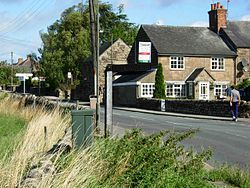Holbrook, Derbyshire
| Holbrook | |
| Derbyshire | |
|---|---|
 Holbrook Moor. | |
| Location | |
| Grid reference: | SK364449 |
| Location: | 53°0’4"N, 1°27’29"W |
| Data | |
| Population: | 1,538 (2011) |
| Post town: | Belper |
| Postcode: | DE56 |
| Local Government | |
| Council: | Amber Valley |
| Parliamentary constituency: |
Amber Valley |
Holbrook is a village in Derbyshire at the southern end of the Pennines about two miles to the north-east of Duffield and around five miles north of Derby. The population of the civil parish as of the 2011 census was 1,538.
History
Holbrook long belonged to the Parish of Duffield, within Duffield Frith. When the latter was seized by King Henry III following the rebellion of Robert de Ferrers, 6th Earl of Derby, Holbrook appears to have been spared. However it became the property of Edmund Crouchback along with the rest of the Frith.
The estate was sold by the Crown to various local copyholders in the reign of Charles I. It included the capital messuage, called Cocksbench, or Coxbench Hall.[1]
St Michael's Church, Holbrook is a simple construction in stone built in 1761 by Rev. S. Bradshaw. It was rebuilt and enlarged in 1841 by the MP, William Evans.
Coxbench
Coxbench, which is a hamlet just to the south, is supposed to have been the "Herdebi" mentioned in the Domesday Survey, as held under Henry de Ferrers; and the adjoining part of the manor of Horsley is supposed to have been the "Herdebi" held under Ralph de Burun.
The hamlet was once served by Coxbench railway station on the Midland Railway Ripley Branch.
Outside links
| ("Wikimedia Commons" has material about Holbrook, Derbyshire) |
References
- ↑ Parishes: Doveridge – Duffield: Magna Britannia: volume 5 (1817) pages 129-142
